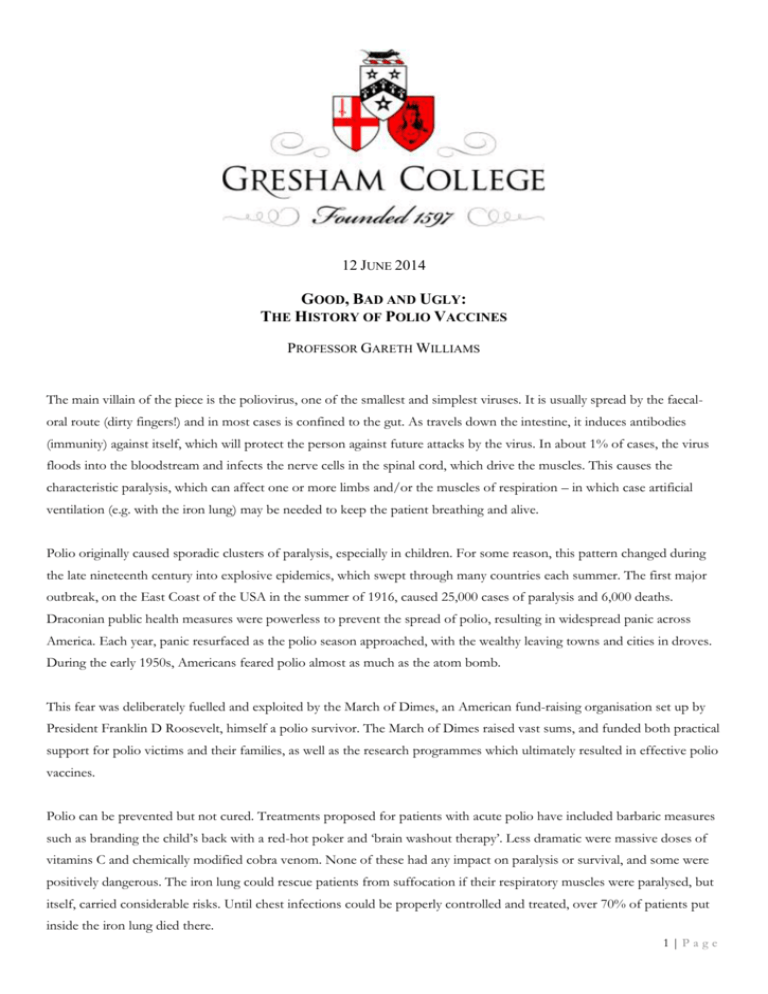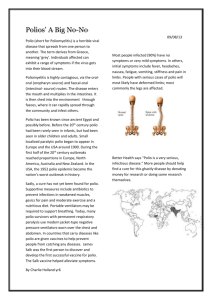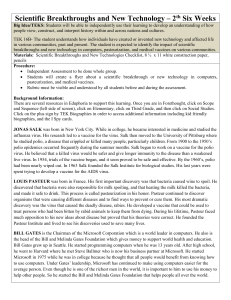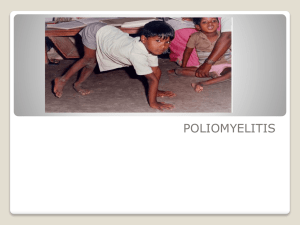Transcript for "Good, Bad and Ugly: The History of Polio Vaccines"
advertisement

12 JUNE 2014 GOOD, BAD AND UGLY: THE HISTORY OF POLIO VACCINES PROFESSOR GARETH WILLIAMS The main villain of the piece is the poliovirus, one of the smallest and simplest viruses. It is usually spread by the faecaloral route (dirty fingers!) and in most cases is confined to the gut. As travels down the intestine, it induces antibodies (immunity) against itself, which will protect the person against future attacks by the virus. In about 1% of cases, the virus floods into the bloodstream and infects the nerve cells in the spinal cord, which drive the muscles. This causes the characteristic paralysis, which can affect one or more limbs and/or the muscles of respiration – in which case artificial ventilation (e.g. with the iron lung) may be needed to keep the patient breathing and alive. Polio originally caused sporadic clusters of paralysis, especially in children. For some reason, this pattern changed during the late nineteenth century into explosive epidemics, which swept through many countries each summer. The first major outbreak, on the East Coast of the USA in the summer of 1916, caused 25,000 cases of paralysis and 6,000 deaths. Draconian public health measures were powerless to prevent the spread of polio, resulting in widespread panic across America. Each year, panic resurfaced as the polio season approached, with the wealthy leaving towns and cities in droves. During the early 1950s, Americans feared polio almost as much as the atom bomb. This fear was deliberately fuelled and exploited by the March of Dimes, an American fund-raising organisation set up by President Franklin D Roosevelt, himself a polio survivor. The March of Dimes raised vast sums, and funded both practical support for polio victims and their families, as well as the research programmes which ultimately resulted in effective polio vaccines. Polio can be prevented but not cured. Treatments proposed for patients with acute polio have included barbaric measures such as branding the child’s back with a red-hot poker and ‘brain washout therapy’. Less dramatic were massive doses of vitamins C and chemically modified cobra venom. None of these had any impact on paralysis or survival, and some were positively dangerous. The iron lung could rescue patients from suffocation if their respiratory muscles were paralysed, but itself, carried considerable risks. Until chest infections could be properly controlled and treated, over 70% of patients put inside the iron lung died there. 1|Page Two rival strategies were used to develop vaccines to protect against polio. Jonas Salk (1914–1998) favoured an ‘inactivated polio vaccine’ (IPV), in which wild polioviruses are ‘killed’ with a powerful chemical, formalin, so that they can no longer replicate and spread into the spinal cord. IPV is injected into a muscle and causes protective antibodies to appear in the bloodstream. The ‘oral polio vaccine’ (OPV) developed by Albert Sabin (1906–1993) relies on the fact that polioviruses forced to grow under unfavourable conditions in the laboratory will mutate into forms that can no longer invade the spinal cord. The OPV virus is still ‘alive’ and able to replicate, but cannot enter the spinal cord and cause paralysis. OPV is taken by mouth and, like a wild poliovirus, induces immunity against itself in the gut wall as it travels through the intestine. It therefore provides a further layer of immune protection compared with the Salk vaccine. Salk and Sabin were arch enemies, and the race to develop their polio vaccines often degenerated into a clash of big egos. In fact, the first useful polio vaccine was an OPV developed in the early 1950s by the flamboyant Hilary Koprowski (1916–2013). Koprowki’s vaccine had promise but fell from favour when clinical trials in Belfast showed that his OPV virus could potentially regain the power to paralyse. Salk’s IPV was the first polio vaccine to be tested on a large scale, in a massive clinical trial in 1954 which involved 1.8 million American children. Convinced that his vaccine was perfect, Salk argued against including proper controls in the trial; fortunately, he was overruled. Following the sensational declaration that his vaccine ‘works and is safe’, Salk became a national and international hero, and mass vaccination of American children with his IPV began immediately. Vaccination continued despite a tragic outbreak of paralytic (and sometimes fatal) polio due to contamination of the Salk vaccine with wild poliovirus – the result of carelessness in the vaccine production plant at Cutter Pharmaceuticals in California. Numbers of paralytic cases and deaths from polio fell dramatically in the USA over the next few years, and Salk’s vaccine was taken up across the world. Sabin’s OPV, being cheaper, more effective and easier to give, later superseded the Salk vaccine. Given correctly, both vaccines protect against polio and are overwhelmingly safe. There is an exceedingly low risk (one in 500,000 vaccinations) of Sabin’s OPV reverting to a paralysing variant – a drawback that Sabin always refused to acknowledge. Polio vaccine not only protects individuals, but if given intensively and on a massive scale, can prevent the virus from spreading and so stamp it out. In 1988, the Global Polio Eradication Initiative (GPEI), which included the World Health Organisation, UNICEF, Rotary International and (later) the Gates Foundation, set out to clear the planet of polio through a world-wide vaccination campaign. The hope was that polio would follow the example of smallpox, which was exterminated by intensive, global vaccination during the late 1970s. Now, after 26 years and $12 billion, polio is now tantalisingly close to being eradicated, with just 200 paralytic cases worldwide in 2012, as compared with over 300,000 in 1988. Tragically, though, endemic polio continues to cling on in three areas – Afghanistan, Pakistan and Northern Nigeria, largely because of anti-western ideology that is backed up by intimidation, death-threats and the murder of many vaccinators and their supporters. Refugees and other travellers have 2|Page reintroduced polio to other countries – Syria, Lebanon and various African states – which had been previously cleared of polio. Unfortunately, it is now very unlikely that polio will be eradicated within the next two to three years. The final extermination of the virus will depend as much on diplomacy as on medicine and science © Professor Gareth Williams, 2014 3|Page






